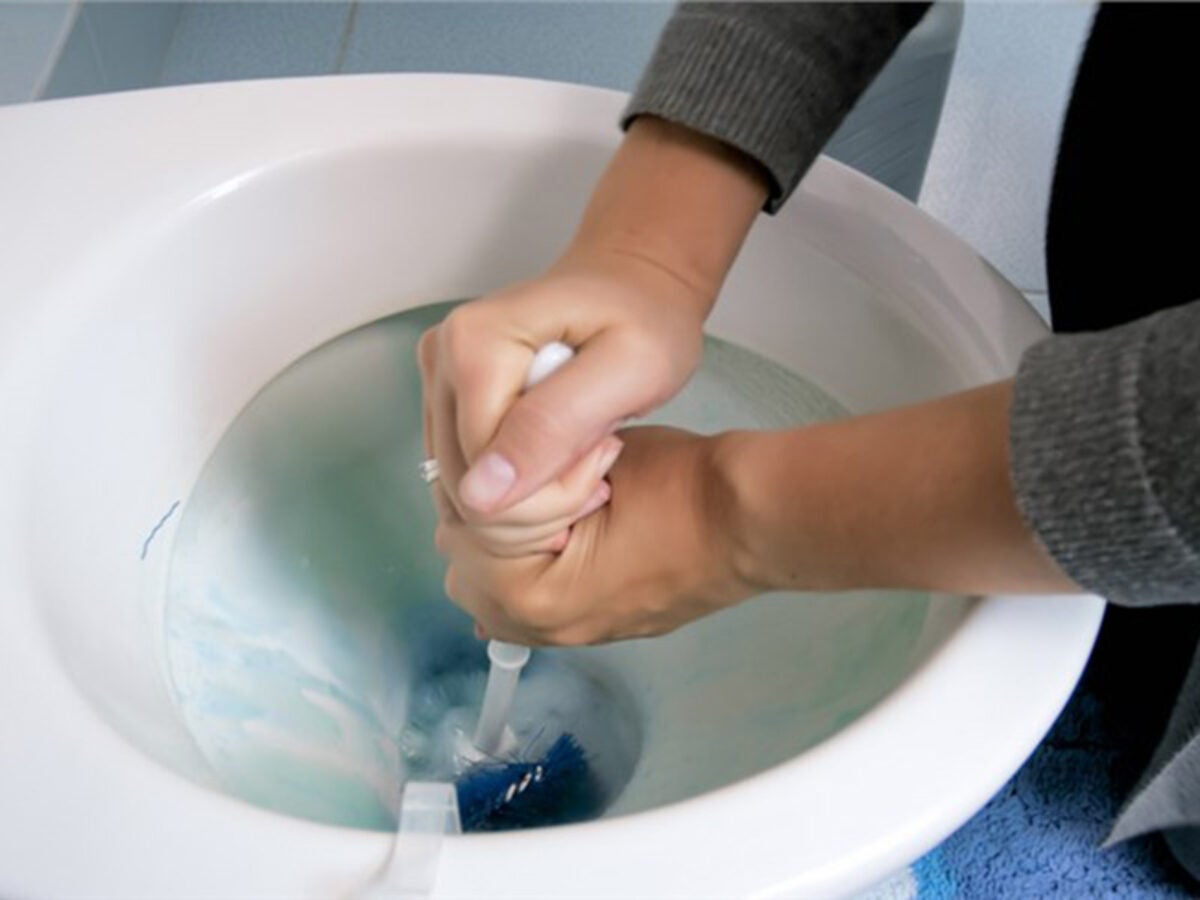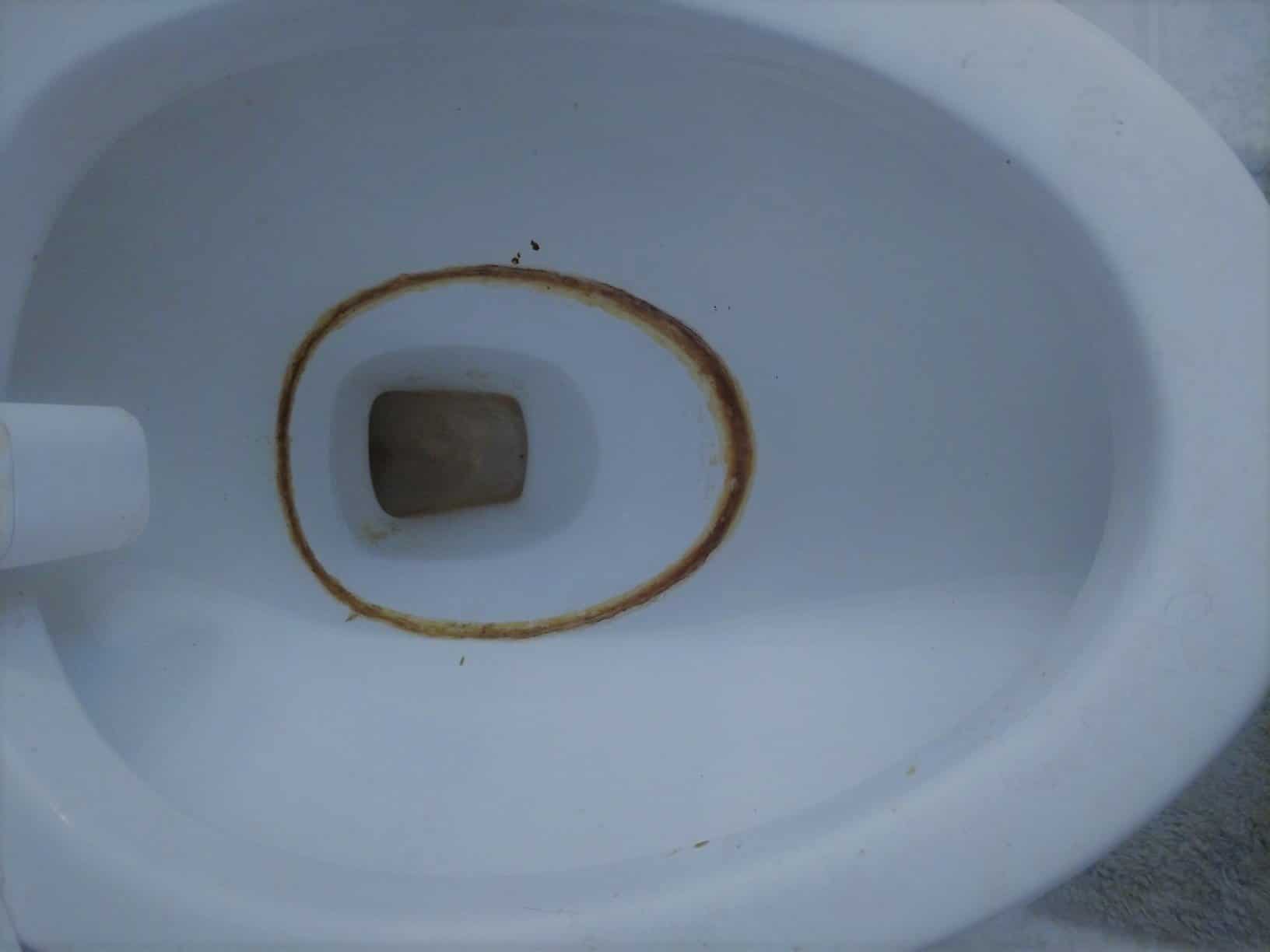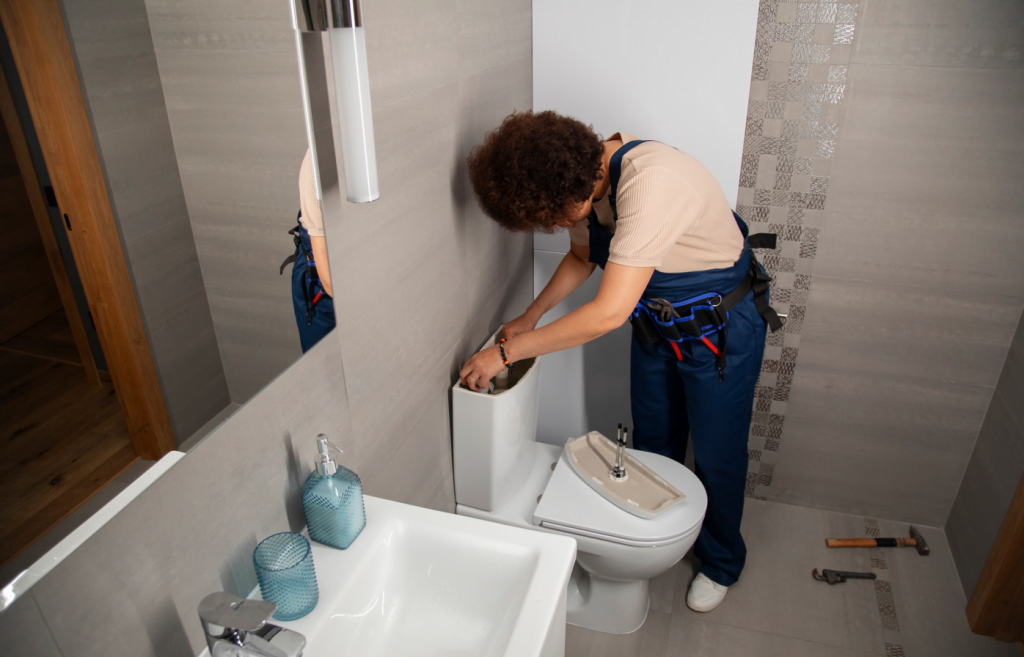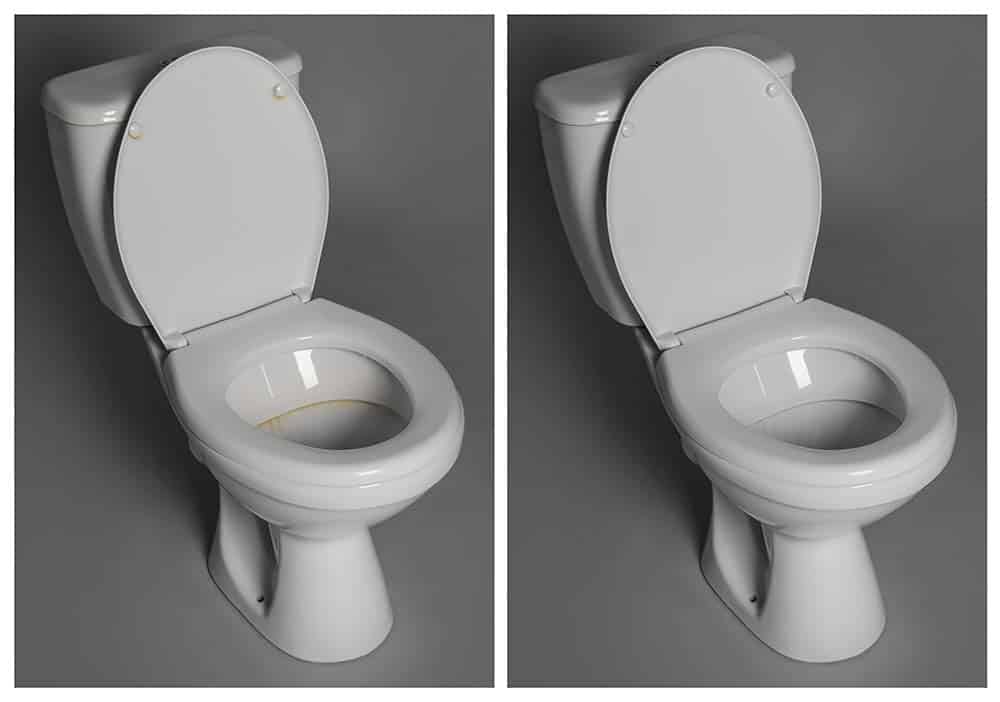Why Does My Toilet Keep Getting a Black Ring often indicates mold growth or mineral deposits. Frequent use and stagnant water can cause these unappealing stains.
Toilets are essential in any home, and keeping them clean is a top priority for both hygiene and aesthetics. A black ring at the water line of your toilet bowl can be an unsightly and frustrating issue. This common bathroom problem usually arises from a combination of factors including the presence of hard water, which leaves mineral deposits, and the growth of mold or mildew due to consistent moisture.
Maintaining a regular cleaning schedule is crucial to prevent the buildup that leads to these rings. Being vigilant about toilet maintenance can help in avoiding the growth of bacteria and ensuring that the toilet remains clean and hygienic for daily use. Remember, a clean toilet not only looks better but also contributes to the overall healthiness of your bathroom environment.
Introduction To Toilet Bowl Stains
Imagine a sparkling clean bathroom. Now, picture a stubborn black ring in the toilet bowl distorting that image of cleanliness. Tough, unsightly toilet bowl stains, especially black rings, are common yet misunderstood nuisances. They blemish the porcelain throne, causing distress and confusion. Here’s a deep dive into what these stains really are and why they keep reappearing.
Understanding Black Rings: An Overview
Toilet bowls develop black rings for various reasons. Mineral deposits from hard water build up over time, creating dark stains. Molds and bacteria thrive in moist environments, often forming a black ring at the water line. Additionally, regular wear and chemical reactions between cleaning agents and water minerals leave behind these unsightly marks. Let’s explore these unwanted bowl blemishes in detail.
Common Misconceptions About Toilet Stains
Many people think a black ring means a dirty toilet. This isn’t always true. Cleanliness is crucial, but these rings can form even in the most well-maintained facilities. Others suspect that the stains indicate damage to the porcelain, which rarely happens. To maintain a spotless toilet, knowing the truth about these common myths is the first step to prevention and removal.
- Misconception: Black rings are always caused by lack of cleaning.
- Truth: They can occur despite regular cleaning.
- Misconception: Toilet bowl cleansers prevent stains.
- Truth: Some cleaners may contribute to staining.
The Science Behind Black Ring Formation
Have you ever noticed an unsightly black ring at the waterline of your toilet bowl? You are not alone. Understanding why this happens can help prevent future stains. It lies in the interaction between water chemistry, microscopic life, and the air in your bathroom. Let’s explore the science that causes these stubborn rings to form.
Explaining The Chemistry Of Stains
Toilets are prone to stains due to their constant contact with water. The water itself carries dissolved minerals and organic compounds. As the water sits, evaporation occurs, leaving behind these substances. They bond with the porcelain, creating the infamous black ring. This process is a mix of chemistry and physics.
Bacteria And Microorganism Growth
Bacteria love moist environments, making your toilet a perfect home. The black ring can be a colony of microorganisms that thrive in such conditions. Their presence indicates a need for cleaning. They can cause unpleasant odors, too. Regular cleaning disrupts these colonies, keeping your bowl fresher and cleaner.
Mineral Deposits: Hard Water Culprits
Hard water contains high levels of minerals like calcium and magnesium. These minerals cause limescale and other deposits. These buildups not only look bad but can also damage your toilet over time. Frequent cleaning with a descaling agent can prevent this buildup. Using a water softener can reduce the minerals in your water, combating the formation of the black ring from the source.
Contributing Factors To Black Ring Development
An unwelcome sight in any bathroom is the notorious black ring circling the toilet bowl. This unsightly mark is not just a cleaning nuisance but also serves as a telltale sign of underlying issues. Understanding the root causes of these persistent stains is the first step towards maintaining a pristine and hygienic bathroom environment. Let’s explore the major contributors to black ring development.
Infrequent Cleaning And Maintenance
A primary cause of black ring formation is negligence in routine cleaning. As toilets are used daily, they require regular maintenance to prevent build-up of mold, mildew, and mineral deposits.
- Water sitting in the bowl leads to staining and mold growth.
- Skipping regular scrubs allows residue to settle and harden.
- Damp conditions are perfect for black mold to thrive.
Toilet Material And Coating Deterioration
The material and protective coating of your toilet play a significant role in stain resistance. Prolonged use leads to wear and tear, reducing the effectiveness of the toilet’s defense against stains.
- Porcelain surfaces can become etched and more stain-prone with time.
- Coatings that resist stains and microbes may degrade.
- Scratches in the toilet bowl create niches for bacteria and mold.
Impact Of Household Cleaning Agents
Ironically, the very products meant to keep the bowl clean can sometimes contribute to the problem. Harsh chemicals found in cleaners can damage the toilet surface over time.
| Common Cleaning Agents | Potential Impact |
|---|---|
| Bleach-based products | Can corrode metal and deteriorate coatings |
| Abrasive powders | May scratch and dull the surface |
| Acidic cleaners | Can etch porcelain and degrade sealants |
Alternative cleaning solutions that are gentle on toilet surfaces should be used to avoid these issues and preserve the longevity of the toilet bowl’s surface.
Health Implications Of Black Rings In Toilets
The presence of a black ring in your toilet may signal more than a simple cleaning issue. Health risks are inherent with any form of unaddressed bathroom mold or bacterial growth. Understanding the potential health effects can motivate homeowners to maintain a hygienic bathroom environment.
Potential Risks Of Bacterial And Mold Exposure
Bacteria and mold that contribute to toilet bowl black rings can pose risks to human health. Breathing in mold spores or coming into contact with bacteria can trigger allergic reactions, respiratory issues, or other ailments. Specifically:
- Allergies: Mold can cause sneezing, itchy eyes, and skin rashes.
- Asthma: Mold spores can worsen asthma in affected individuals.
- Infections: Some bacteria can cause urinary tract or skin infections.
The Importance Of Maintaining A Hygienic Bathroom
Cleaning regularly eliminates contaminants that lead to the dreaded black ring. Consider these tips for a cleaner toilet:
- Regular Scrubbing: Using a toilet brush reduces buildup.
- Mild Cleaners: They protect your toilet’s surface.
- Flush After Use: This habit prevents stain formation.
Keep the bathroom ventilated to reduce mold-friendly humidity. A clean and dry bathroom is less likely to harbor harmful microbes.
Preventative Measures Against Black Ring Formation
Wondering why black rings form in a toilet bowl? These unsightly stains often arise from mold, mildew, and mineral buildup. Luckily, there are several steps to prevent this annoying problem. A clean toilet not only looks and smells better, but it is also more hygienic. Let’s tackle how to keep your toilet pristine and ring-free.
Regular Cleaning Schedules And Techniques
Cleaning your toilet regularly is the first step to prevent black rings. Schedule cleanings at least once a week to stop buildup. Use these techniques for best results:
- Use a toilet brush to scrub under the rim and bowl.
- Clean hard-to-reach areas with a smaller brush or old toothbrush.
- Flush after scrubbing to rinse away deposits that cause staining.
Selecting The Right Cleaning Products
Choosing the proper cleaners can make a big difference. Here are some tips:
- Use chlorine bleach in moderation to kill mold and mildew.
- Try natural alternatives like vinegar and baking soda for a safe, effective clean.
- Look for products labeled as safe for septic systems and your toilet’s materials.
Water Softening Solutions
Hard water can contribute to mineral buildup leading to black rings. Consider water softening solutions to combat hard water issues:
| Method | Benefits |
|---|---|
| Ion Exchange Softeners | Remove minerals that cause buildup. |
| Magnetic or Electronic Softeners | Alter the properties of minerals without chemicals. |
| Chelation Systems | Bind minerals in water to prevent deposits. |

Effective Cleaning Solutions For Black Rings
The persistent black ring in the toilet is an unsightly issue that many homeowners face. Often caused by mineral deposits, mold, or mildew, this stubborn stain demands a strategic approach to cleaning. Thankfully, there are effective solutions to restore the gleam to your toilet bowl. Let’s dive into the methods that can make your toilet look new again.
Natural Home Remedies To Tackle Stains
For those who prefer eco-friendly options, several natural remedies can remove black rings without harsh chemicals. Here are some tried-and-true solutions:
- Baking Soda and Vinegar: This combination foams up, lifting stains naturally.
- Borax: Sprinkle, let it sit, and scrub away the grime.
- Lemon Juice: Its natural acidity breaks down stains.
Commercial Cleaners: What To Look For
When selecting a commercial cleaner, aim for those designed specifically for toilet bowls. Key factors include:
| Characteristic | Benefit |
|---|---|
| Chlorine Bleach | Eliminates mold and mildew |
| Hydrochloric Acid | Removes tough mineral deposits |
| Surfactants | Ensures thorough cleaning |
Mechanical Cleaning Tools And Their Usage
Mechanical tools enhance the cleaning process by providing the necessary abrasion to remove stubborn stains. These include:
- Toilet Brush: Daily use prevents stain buildup.
- Pumice Stone: Gently scrubs away mineral deposits.
- Scouring Pad: Ideal for removing mildew and mold.
Troubleshooting Persistent Black Ring Issues
That mysterious black ring in the toilet bowl can be stubborn. It might signal mold, mineral deposits, or other concerns. Simple steps often solve the problem. But if those rings keep coming back, it’s time for a deeper dive. Below you’ll find a clear roadmap to tackle those persistent black ring issues.
When To Call A Professional: Seeking Expert Help
Black rings can signify a plumbing concern, need for deep cleaning, or even fixture replacement. If home remedies fail, consider these signs a professional should look closer:
- Black rings reappear quickly, even after cleaning.
- There’s an odor despite regular cleaning.
- Toilet performance changes, with flushing issues or water levels fluctuating.
Plumbers have specialized tools and expertise. They’ll diagnose and solve deeper issues causing those unsightly rings.
Replacing Toilet Components: A Last Resort?
Consider components’ condition before planning a replacement. Scratches or damages inside the bowl make perfect spots for stains to hold. Look for these clues:
- Chips or pits inside the bowl.
- Worn out or faulty components like flappers or fill valves.
- Long-term use and material degradation.
When cleaning no longer cuts it, new components might be the fix. In some cases, upgrading the entire toilet brings the best results. This switch can enhance the look, function, and hygiene of your bathroom.

Case Studies: Real-world Scenarios And Resolutions
Discover how real people have tackled the persistent problem of black rings in their toilets. This section delves into actual cases, revealing the causes and the effective solutions used to remedy the issue. Genuine household stories and the lessons learned offer valuable insights for any homeowner facing similar challenges.
Understanding Different Toilet Environments
In solving the mystery behind the black rings, one must consider the toilet’s environment. Factors such as water quality, frequency of use, and cleaning habits play a crucial role. Let’s explore real-world examples to understand better how these elements affect the formation of black rings.
- Case 1: Hard Water Havoc – In areas with high mineral content in water, black rings often form from mineral deposits. Regular cleaning with a descaling agent turned out to be the solution.
- Case 2: Infrequent Use – Toilets that don’t get flushed often can develop stagnant water lines. Adding a weekly flush routine eliminated the issue.
- Case 3: Inadequate Cleaning Products – Swapping harsh chemicals for pH-neutral cleaners maintained a pristine bowl without encouraging residue build-up.
Success Stories In Removing Black Rings
These success stories prove that there’s hope in erasing those stubborn black rings. Each case highlights a different approach, tailored to the specific situation of the household.
- Baking Soda and Vinegar Triumph: A simple mix of household items was the key. Regular use kept the black rings away.
- Pumice Stone Power: For tougher rings, a pumice stone did the job without scratching the porcelain.
- Flushable Cleaner Clips: A continuous cleaning agent ensured the toilet stayed cleaner longer.
Adopting these methods, many have successfully maintained a spotless toilet bowl, free from the eyesore of a black ring.
Consumer Products Review: Best Toilet Cleaners
A black ring in the toilet is a common and unsightly problem. The right cleaner can fix it. In this review, we’ll discover top products for a sparkling bowl. Bold choices will reveal the best for your bathroom clean-up routine. Let’s dive into the products that promise ring-free toilets.
Analyzing The Top Products On The Market
Essential criteria shape our product analysis. Effectiveness, ease of use, and cost-value balance are crucial. We analyze user reviews and test results. Top brands and lesser-known gems get fair scrutiny. Our goal: to help you choose a toilet cleaner that delivers.
| Brand | Type | User Rating |
|---|---|---|
| CleanRipple | Gel | 4.5/5 |
| EcoBlast | Tablet | 4/5 |
| ShineBright | Liquid | 4.7/5 |
- CleanRipple Gel: Cuts through stains.
- EcoBlast Tablets: Safe for septic tanks.
- ShineBright Liquid: Leaves a lasting shine.
Eco-friendly Vs. Chemical Cleaners: A Comparison
Eco-friendly options boast natural ingredients. They are gentle yet effective. Chemical cleaners offer powerful action. They may pose risks to health and environment. Understanding these differences is important. A side-by-side comparison sheds light on what’s best for your toilet.
| Aspect | Eco-friendly | Chemical |
|---|---|---|
| Ingredients | Natural, plant-based | Synthetic compounds |
| Impact on Environment | Low | High |
| Cleaning Power | Moderate to high | High |
- Select the right cleaner for your bathroom.
- Consider both cleaning power and environmental impact.
- Check user reviews and eco-certifications.
Do’s And Don’ts In Toilet Ring Prevention
Do’s and Don’ts in Toilet Ring Prevention often hinge on regular maintenance and correct cleaning techniques. A black ring in a toilet can be unsightly and may indicate mold or mineral buildup. Understanding effective prevention methods is key to keeping the toilet sparkling clean.
Best Practices For Toilet Care
Caring for a toilet correctly extends its life and keeps it hygienic. Follow these best practices:
- Clean regularly with a non-abrasive toilet cleaner.
- Use a toilet brush for scrubbing away stains and rings.
- Flush after each use to prevent stagnation.
- Check for leaks that could cause rust or mold.
- Natural cleaners like vinegar and baking soda can help.
Common Mistakes To Avoid In Toilet Maintenance
Simple oversights can lead to stubborn toilet rings. Steer clear of these common mistakes:
- Ignoring hard water which can cause mineral buildup.
- Avoid harsh chemicals that could damage the toilet’s surface.
- Don’t leave cleaning products in the toilet too long; follow instructions.
- Neglecting to clean under the rim can lead to hidden mold.
- Skipping regular cleaning schedules allows stains to set.
Q&a: Addressing Common Concerns About Toilet Rings
Notice a stubborn black ring in your toilet bowl? You’re not alone. Many homeowners share in the struggle of keeping their toilets pristine. In this part of our blog post, we delve into the common questions and concerns about those mysterious toilet rings. From what causes them to how to remove them, we’ve gathered expert insights to quell your concerns.
Expert Answers To Frequently Asked Questions
- What causes black rings in my toilet?
- The black ring is usually mildew or mineral deposits. Water composition and frequent use create these rings.
- Can I prevent these rings from forming?
- Yes, regular cleaning with the right products can prevent ring formation.
- Are in-tank cleaners effective?
- Some can reduce rings but may damage toilet components over time.
Myths Vs. Facts: What You Need To Know
| Myth | Fact |
|---|---|
| Bleach is best for removing toilet rings. | Mild cleaners can be more effective and safer for your toilet. |
| Toilet rings mean poor cleaning. | Rings can form even with good hygiene due to water quality. |
| Scrubbing with a pumice stone is safe. | Be gentle. Pumice stones can scratch ceramic surfaces. |
Conclusion: Emphasizing The Importance Of A Clean Toilet
A consistently clean toilet isn’t just a matter of pride; it’s essential for health and hygiene. A black ring in the toilet is unsightly and hints at underlying issues. It’s key to address and prevent it. By looking at common causes, we’ve learned effective solutions. Maintain a routine to secure a sparkling, hygienic bathroom.
Summarizing Key Takeaways
- Black rings often result from mold, mildew, or minerals.
- Regular cleaning with appropriate agents is beneficial.
- Proper ventilation helps stop mold growth.
- Using water softeners can combat mineral deposits.
Encouraging Consistency In Toilet Upkeep
Maintain a regular cleaning schedule to prevent black rings. Address stains as they appear. Use safe, effective cleaners made for toilets. Avoid harsh chemicals that can harm plumbing.
Actions as simple as flushing regularly and using a toilet brush can make a big difference. Cleaning your toilet consistently keeps it free from bacteria and stains. So, roll up your sleeves and keep that porcelain throne spotless!

Frequently Asked Questions For Why Does My Toilet Keep Getting A Black Ring
What Causes Black Rings In Toilets?
Black rings in toilets are usually caused by mold or mildew growth. They thrive in moist environments, like under the rim of your toilet. Hard water deposits can also attract mold, creating the unsightly black ring.
How Can I Prevent Toilet Bowl Black Rings?
To prevent black rings, clean your toilet regularly with a disinfectant cleaner. Also, consider using a water softening agent if hard water is an issue. Good ventilation helps reduce moisture and prevent mold growth.
Are Toilet Black Rings A Sign Of Leakage?
Black rings themselves are not usually a sign of a leak. They are more often an indicator of mold or mineral buildup. However, leaking could contribute to the excess moisture that promotes ring formation, so it’s worth checking for leaks.
Can Pumice Stones Remove Toilet Black Rings?
Yes, pumice stones can remove toilet black rings effectively. It’s a natural abrasive that can scrub away the stains without damaging the toilet bowl. Use it gently to prevent scratches and always wet the stone before use.
Conclusion
Tackling the persistent black ring in your toilet bowl can be a nuisance. Regular cleaning, targeted treatments, and monitoring water quality are key. Remember, preventing mold and mineral buildup protects your bathroom’s hygiene and aesthetic. For a fresher toilet, start these simple steps today and say goodbye to those unsightly marks.

